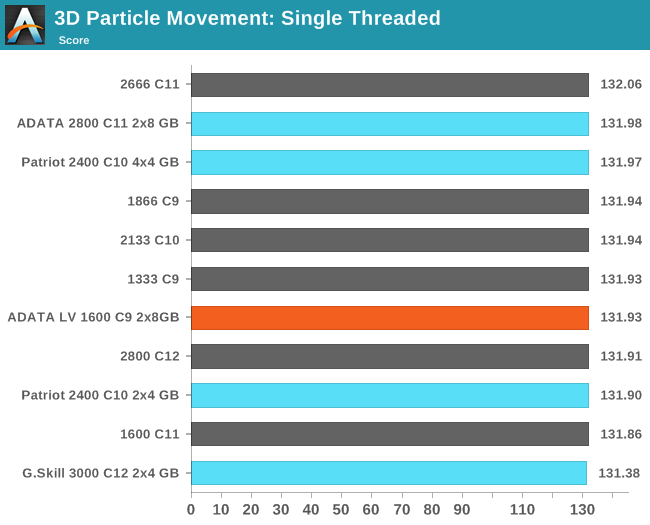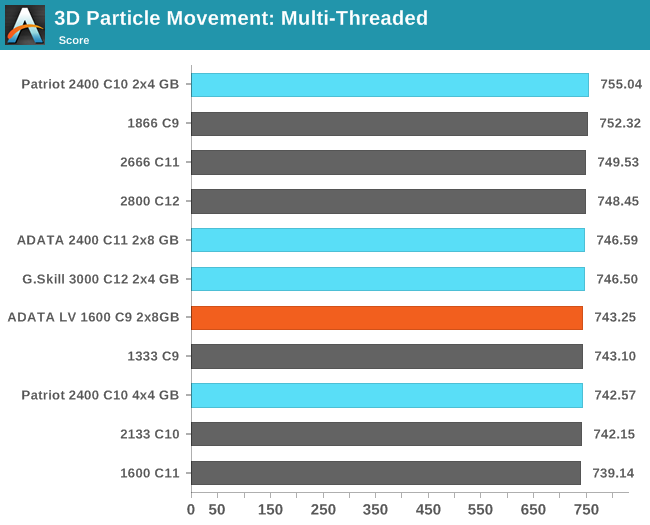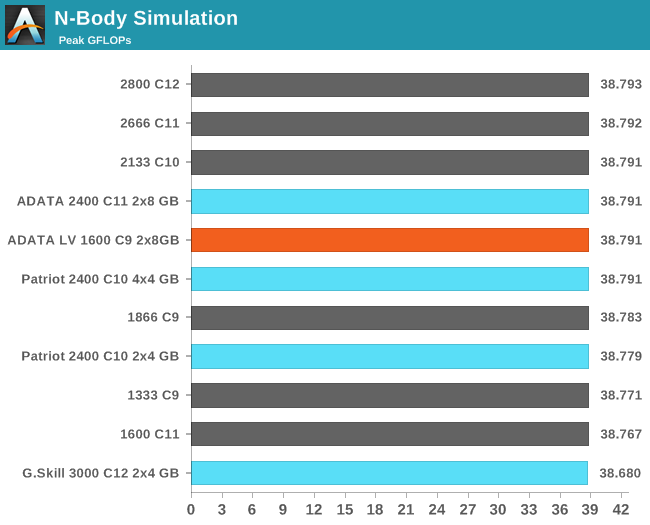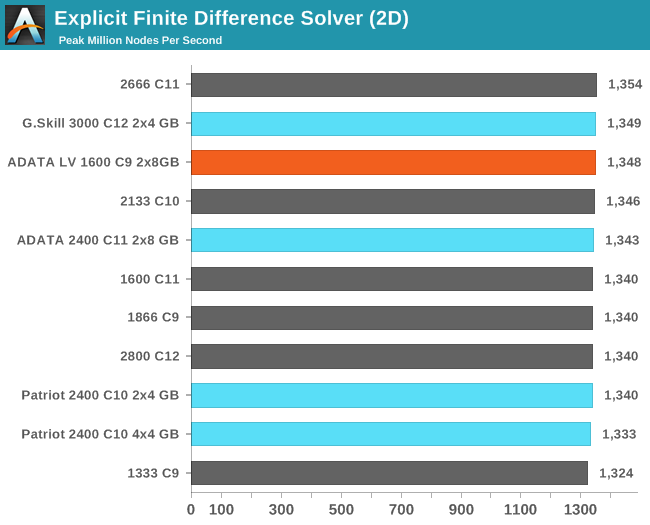ADATA XPG V1.0 Low Voltage Review: 2x8 GB at DDR3L-1600 9-11-9 1.35 V
by Ian Cutress on December 6, 2013 2:00 PM ESTCPU Compute
One side I like to exploit on CPUs is the ability to compute and whether a variety of mathematical loads can stress the system in a way that real-world usage might not. For these benchmarks we are ones developed for testing MP servers and workstation systems back in early 2013, such as grid solvers and Brownian motion code. Please head over to the first of such reviews where the mathematics and small snippets of code are available.
3D Movement Algorithm Test
The algorithms in 3DPM employ uniform random number generation or normal distribution random number generation, and vary in various amounts of trigonometric operations, conditional statements, generation and rejection, fused operations, etc. The benchmark runs through six algorithms for a specified number of particles and steps, and calculates the speed of each algorithm, then sums them all for a final score. This is an example of a real world situation that a computational scientist may find themselves in, rather than a pure synthetic benchmark. The benchmark is also parallel between particles simulated, and we test the single thread performance as well as the multi-threaded performance. Results are expressed in millions of particles moved per second, and a higher number is better.


N-Body Simulation
When a series of heavy mass elements are in space, they interact with each other through the force of gravity. Thus when a star cluster forms, the interaction of every large mass with every other large mass defines the speed at which these elements approach each other. When dealing with millions and billions of stars on such a large scale, the movement of each of these stars can be simulated through the physical theorems that describe the interactions. The benchmark detects whether the processor is SSE2 or SSE4 capable, and implements the relative code. We run a simulation of 10240 particles of equal mass - the output for this code is in terms of GFLOPs, and the result recorded was the peak GFLOPs value.

Grid Solvers - Explicit Finite Difference
For any grid of regular nodes, the simplest way to calculate the next time step is to use the values of those around it. This makes for easy mathematics and parallel simulation, as each node calculated is only dependent on the previous time step, not the nodes around it on the current calculated time step. By choosing a regular grid, we reduce the levels of memory access required for irregular grids. We test both 2D and 3D explicit finite difference simulations with 2n nodes in each dimension, using OpenMP as the threading operator in single precision. The grid is isotropic and the boundary conditions are sinks. We iterate through a series of grid sizes, and results are shown in terms of ‘million nodes per second’ where the peak value is given in the results – higher is better.


Grid Solvers - Implicit Finite Difference + Alternating Direction Implicit Method
The implicit method takes a different approach to the explicit method – instead of considering one unknown in the new time step to be calculated from known elements in the previous time step, we consider that an old point can influence several new points by way of simultaneous equations. This adds to the complexity of the simulation – the grid of nodes is solved as a series of rows and columns rather than points, reducing the parallel nature of the simulation by a dimension and drastically increasing the memory requirements of each thread. The upside, as noted above, is the less stringent stability rules related to time steps and grid spacing. For this we simulate a 2D grid of 2n nodes in each dimension, using OpenMP in single precision. Again our grid is isotropic with the boundaries acting as sinks. We iterate through a series of grid sizes, and results are shown in terms of ‘million nodes per second’ where the peak value is given in the results – higher is better.











35 Comments
View All Comments
MrSpadge - Sunday, December 8, 2013 - link
> Does low voltage ram avoid this?Nope. It's actually the signal quality and not the power draw which causes them to downclock. I've got a X79 build with 8x8 GB where I simply set XMP at stock frequency (1600 or 1866) and it works without problems. I think it's the same as overclocking memory and controller: Intel doesn't want to validate this, but this doesn't mean it would not work.
BlueReason - Saturday, December 7, 2013 - link
Do you ever look at all the charts full of near-identical sized bars and ask yourself just how worthwhile these RAM reviews are?ShieTar - Tuesday, December 10, 2013 - link
Well, some RAM testing is fundamentally important, in order to understand how much impact there is with current CPUs, RAM, Software, etc.What may be less useful is posting a full article that shows just how little impact there is right now, and then following it up with a steady stream of single RAM tests that only keep on reporting the same conclusion over and over.
cjs150 - Monday, December 9, 2013 - link
I use low profile/low voltage samsung green for my HTPC (which is fanless). Lower voltage = less heat which is obviously beneficial in a fanless computer. The fact that the samsungs were the same price as a good name standard ram meant the decision was very simple.If not going fanless then I would still go for the samsungs where memory height was an issue for a big CPU cooler.
Low voltage is a niche
blackie333 - Tuesday, December 10, 2013 - link
A have a brand new Haswell build with 4670K, Asus Z87-Pro and G.Skill 2400C10 memory. I was quite surprised that in idle mode G.Skill@2400Mhz is consuming much more energy(10Watts) than CPU cores (1-5 watts).Is there any bios setting (except setting DRAM frequency manually too low) to make memory be more effective in idle state(s)? Thank you in advance for advice